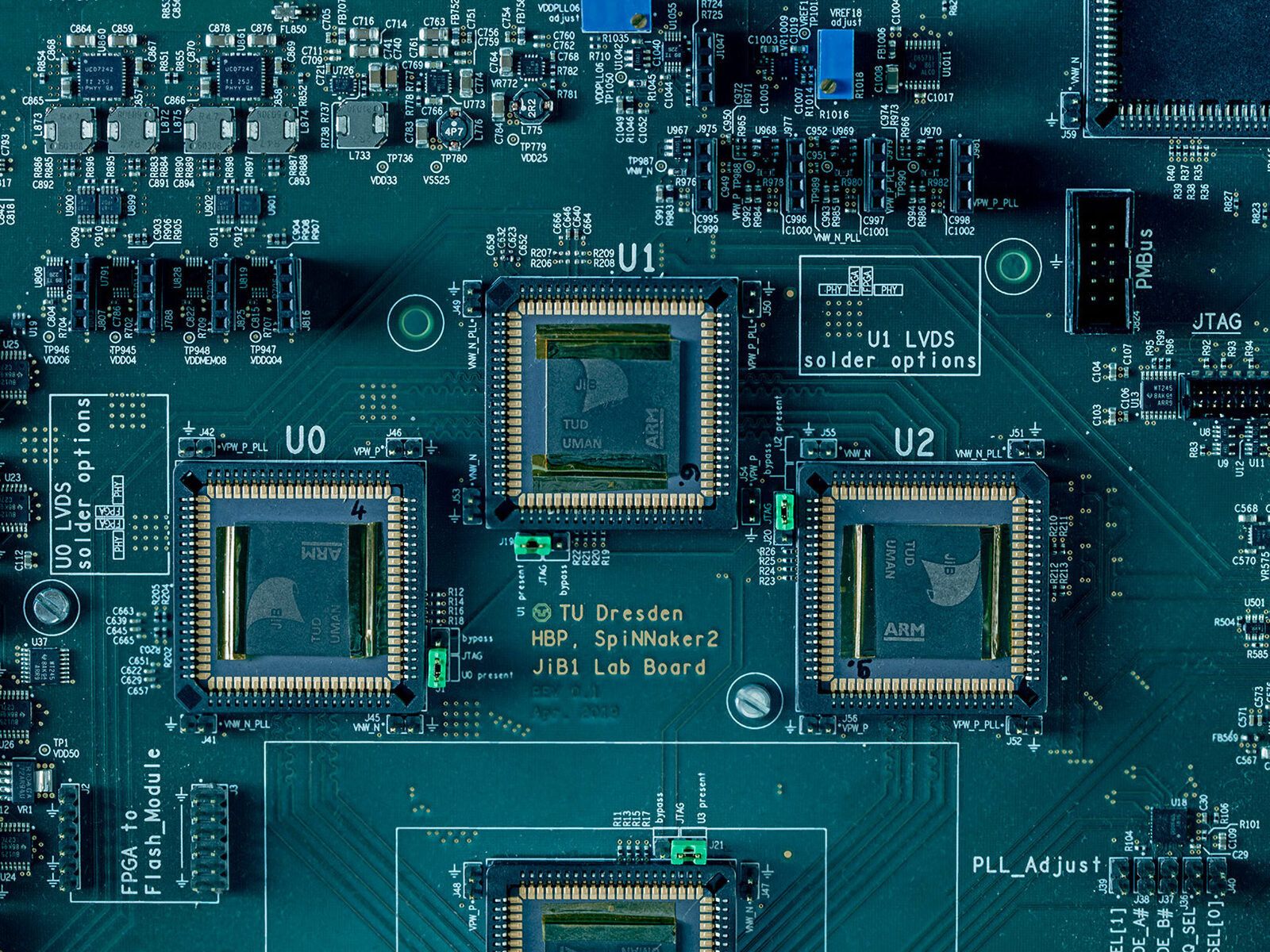
Smart cities, 5G and autonomous driving hold the promise to improve the quality of life in the future. But these technologies also require a massive increase in computer processing power. This is a challenge that current microprocessors have been unable to meet. A new computer chip is about to change that.
Make that 70,000 chips. This is the number of SpiNNaker2 chips that will form a cloud spread out across 16 server cabinets at the Technical University of Dresden, Germany. Not only is the sheer number impressive, each one is designed with the ultimate computing machine in mind: the human brain.
The brain benchmark
The brain is far better at processing than any computer chip. It is both faster and more efficient. Each neuron is connected to another neuron with 7,000 synapses. The brain also conserves energy by transmitting only necessary communication. It makes decisions on what information is relevant to a problem, transmits that information only and therefore consumes less energy. The SpiNNaker2 chip actually has accelerators in it that simulate neurons and synapses. In this sense, it is a miniature artificial intelligence network.
Christian Mayr, Professor in charge of the Chair of Highly-Parallel VLSI Systems and Neuro-Microelectronics at the Technical University of Dresden, was a contributor to the development of the SpiNNaker2 chip. He used the functioning of the brain as a guideline in its development and describes himself as “strongly biology-inspired.” That’s why this supercomputer, which brings together artificial intelligence and brain biology, is clearly superior to “classical AI.”
The name of the chip, SpiNNaker2 (which rhymes with vinegar for the non-sailors among you), conjures up visions of a sailboat clipping along on the waves with a spinnaker sail. An appropriate name. The SpiNNaker2 is poised to accelerate processing power into the future. It is also referred to as a neuromorphic chip and an intelligent processing unit, a neural processing unit designed to accelerate neural network processing. Such chips are expected to greatly accelerate the efficiency of artificial intelligence (AI) applications.
As project contributor Prof. Steve Furber (University of Manchester) states: “There is still a great deal to learn from biology if we are to realize the full potential of AI in the future. SpiNNaker2 has been designed to bridge the gulf between realistic brain models and AI so that each may increasingly be informed by the other.”
Scalable, faster, more efficient,
The SpiNNaker2 chip also has the advantage of being scalable from edge devices up to large-scale server/cloud applications without suffering from the slow-down that usually results from scaling computing up to cloud dimensions. SpiNNaker2 is designed to scale up to a 70,000-chip cloud system while still maintaining real-time operation. It is a key enabler for real-time AI at massive data rates.
The new chip will significantly impact AI applications such as smart cities, 5G, and autonomous driving. These are challenges beyond the capabilities of current hardware because of their high processing demands. Large amounts of data are generated by such applications, data that must be processed quickly and efficiently. These are big data tasks that the SpiNNaker2 chip is able to handle with its supercomputing power.
Another, lesser-known AI application that will be enabled by this new chip is the tactile internet. As the name implies, it will add a new dimension to interactions with computers by tactile sensations possible. It will also revolutionize the interaction of machines by enabling the control of IoT in real time.
The SpiNNaker2 machine, called SpiNNcloud, will be deployed at the Technical University of Dresden for research purposes. In parallel, the startup SpiNNcloud Systems GmbH, a high-tech spinoff of the same university, will make SpiNNaker2 commercially available.
The SpiNNaker2 chip is part of the EU-sponsored Human Brain Project and is a simulation model of the human brain. This is one of the three Future and Emerging Technology flagship projects of the EU. It was launched in 2013 and is one of the largest research projects in the world. More than 500 scientists and engineers at over 140 universities, teaching hospitals and research institutions across Europe come together to research the human brain.
Ready for manufacturing
The SpiNNaker2 developers recently announced that the tapeout – the final result of the design process for printed circuit boards – is now finished and ready to be sent for manufacturing. It is based on its predecessor SpiNNaker, developed by the same institutions: University of Manchester, UK; Technical University Dresden, Germany; and Global Foundries and Racyics, both in Dresden. The chip will be manufactured by Global Foundries in Dresden, Germany, the largest semiconductor plant with the most modern manufacturing facilities in Europe.
More SpiNNakers in the pipeline
Christian Mayr’s team at the Technical University of Dresden is already working on the next SpiNNaker generation of chips: “In the future, one of our chips could be installed in every robot joint, making the detour via a central computer obsolete in many cases. This will significantly improve the training of the robot’s own kinematics.”
Title photo: Sprind.org
Also interesting:
One of the fastest supercomputers lives in Munich
France takes next step in quantum technology with Dutch processor
Europe’s once-in-a-lifetime chance to reduce emissions in computer technology







